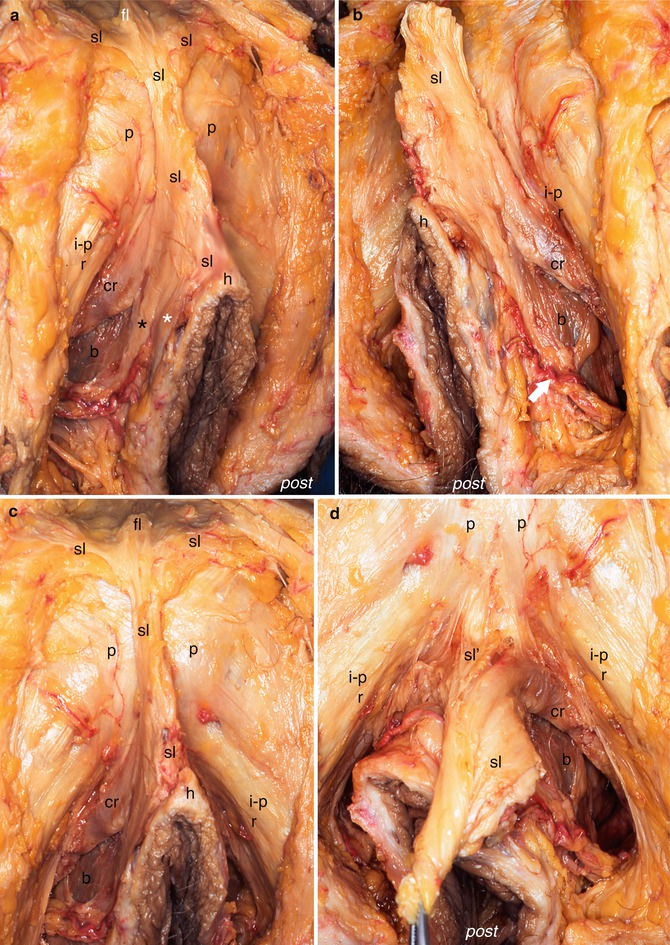and Hubert Lepidi1
(1)
UER Médecine, Aix-Marseille Université, Marseille, France
Abstract
This ligament is a fibro-elastic and fatty formation, which connects the bulbo-clitoral organ to the pubic symphysis and to the infra-umbilical linea alba. In spite of its volume and size, few authors have actually studied this formation and most of the authors, who have written about the clitoris, have simply pointed out the existence of this formation or provided erroneous representations, such as a minuscule symphysis fibrous attachment. It is Poirier and Charpy, in 1901, who provided the first anatomical description of this ligament.
This ligament is a fibro-elastic and fatty formation, which connects the bulbo-clitoral organ to the pubic symphysis and to the infra-umbilical linea alba. In spite of its volume and size, few authors have actually studied this formation and most of the authors, who have written about the clitoris, have simply pointed out the existence of this formation or provided erroneous representations, such as a minuscule symphysis fibrous attachment. It is Poirier and Charpy, in 1901, who provided the first anatomical description of this ligament.
At first sight, the shape of the ligament is that of a quadrangular pyramid, with a clitoral base and a prepubic and sagittally flattened top. The ligament insertions at the level of the clitoris protrude ahead of the elbow and overflow onto the descending part of the body and may even reach the glans. These insertions are present on the corporeal albuginea and spread to overflow over the lateral sides of the latter. Certain fibres of the ligament meet on the inferior surface of the clitoral body to form a sort of hammock. Other fibres extend laterally on either side of the clitoral body and are lost in the derma of the labia majora (Fig. 12.1). Some fibres also reach the medial part of the bulbospongiosus muscle. The ligament extends with the fibrous tissue of the retro-crural fascia and is connected, with the latter, to the pre-symphysis fibrous coating, at the level of the crura and of the ascending portion of clitoral body. From this clitoral base, the ligament pyramid can be described as follows (Fig. 12.1):


Fig. 12.1
Four pictures of a prepubic dissection to demonstrate the position of suspensory and fundiform ligaments. (a, c) Right lateral view and anterior view showing the suspensory ligament in place. (b, d) Left lateral views showing the suspensory ligament partially detached. b bulb, cr crus, fl fundiform ligament, h hood, i–p r ischio-pubic ramus, p pubis, sl suspensory ligament, superficial portion, sl′ suspensory ligament, deep portion. The White asterisk shows ligamentary fibres extending in the derma of labia majora. The Black asterisk shows ligamentary fibres reaching the medial part of the bulbo-spongiosus muscle. The white arrow shows the neuro-vascular bundle (bulbar vessels and bulbar nerve).
Two large triangular lateral surfaces, whose base measures on average 2.3 cm and extends from the retro-crural fascia to the junction between the body and the glans clitoridis.
A ventral surface corresponding to the thickness of the ligament (3–4 mm), which becomes wider at the level of its clitoral attachment (around 1 cm large).
A dorsal surface extending without any boundary line with the retro-crural fascia. When this fascia is absent or not very developed, its base measures around 8 mm but when in contact with the pubic symphysis, the ligament insertion spreads out as a triangular surface.
A superior end, which gradually becomes tapered and loses itself on the linea alba, above the pubic insertions of the latter.
The ligament has an overall length of 8–9 cm.
Such as already described by Poirier and Charpy, it is possible to distinguish two parts of the suspensory ligament of the clitoris:
A deep part, attached to the angle of the clitoris and the back of the first centimetres of the body. This part is attached to the retro-crural fascia, on the caudal half of the anterior surface of the pubic symphysis, and its fibres mix with those of the pre-symphysis fibrous coating (Fig. 5.3).1
Stay updated, free articles. Join our Telegram channel

Full access? Get Clinical Tree








